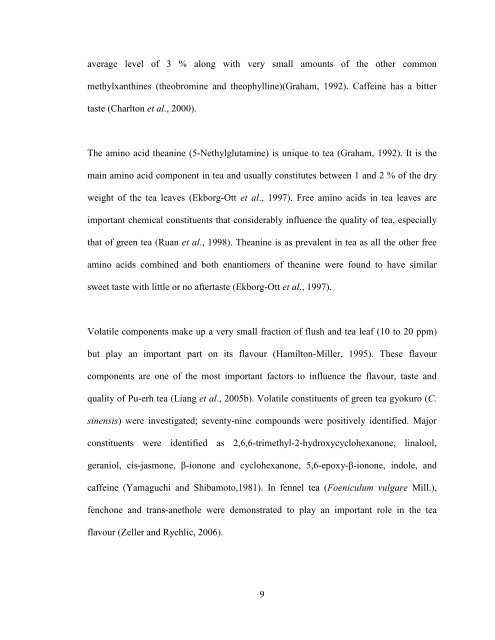a study of the quality of a local herbal tea and volatiles of parinari ...
a study of the quality of a local herbal tea and volatiles of parinari ...
a study of the quality of a local herbal tea and volatiles of parinari ...
Create successful ePaper yourself
Turn your PDF publications into a flip-book with our unique Google optimized e-Paper software.
average level <strong>of</strong> 3 % along with very small amounts <strong>of</strong> <strong>the</strong> o<strong>the</strong>r common<br />
methylxanthines (<strong>the</strong>obromine <strong>and</strong> <strong>the</strong>ophylline)(Graham, 1992). Caffeine has a bitter<br />
taste (Charlton et al., 2000).<br />
The amino acid <strong>the</strong>anine (5-Nethylglutamine) is unique to <strong>tea</strong> (Graham, 1992). It is <strong>the</strong><br />
main amino acid component in <strong>tea</strong> <strong>and</strong> usually constitutes between 1 <strong>and</strong> 2 % <strong>of</strong> <strong>the</strong> dry<br />
weight <strong>of</strong> <strong>the</strong> <strong>tea</strong> leaves (Ekborg-Ott et al., 1997). Free amino acids in <strong>tea</strong> leaves are<br />
important chemical constituents that considerably influence <strong>the</strong> <strong>quality</strong> <strong>of</strong> <strong>tea</strong>, especially<br />
that <strong>of</strong> green <strong>tea</strong> (Ruan et al., 1998). Theanine is as prevalent in <strong>tea</strong> as all <strong>the</strong> o<strong>the</strong>r free<br />
amino acids combined <strong>and</strong> both enantiomers <strong>of</strong> <strong>the</strong>anine were found to have similar<br />
sweet taste with little or no aftertaste (Ekborg-Ott et al., 1997).<br />
Volatile components make up a very small fraction <strong>of</strong> flush <strong>and</strong> <strong>tea</strong> leaf (10 to 20 ppm)<br />
but play an important part on its flavour (Hamilton-Miller, 1995). These flavour<br />
components are one <strong>of</strong> <strong>the</strong> most important factors to influence <strong>the</strong> flavour, taste <strong>and</strong><br />
<strong>quality</strong> <strong>of</strong> Pu-erh <strong>tea</strong> (Liang et al., 2005b). Volatile constituents <strong>of</strong> green <strong>tea</strong> gyokuro (C.<br />
sinensis) were investigated; seventy-nine compounds were positively identified. Major<br />
constituents were identified as 2,6,6-trimethyl-2-hydroxycyclohexanone, linalool,<br />
geraniol, cis-jasmone, β-ionone <strong>and</strong> cyclohexanone, 5,6-epoxy-β-ionone, indole, <strong>and</strong><br />
caffeine (Yamaguchi <strong>and</strong> Shibamoto,1981). In fennel <strong>tea</strong> (Foeniculum vulgare Mill.),<br />
fenchone <strong>and</strong> trans-anethole were demonstrated to play an important role in <strong>the</strong> <strong>tea</strong><br />
flavour (Zeller <strong>and</strong> Rychlic, 2006).<br />
9


